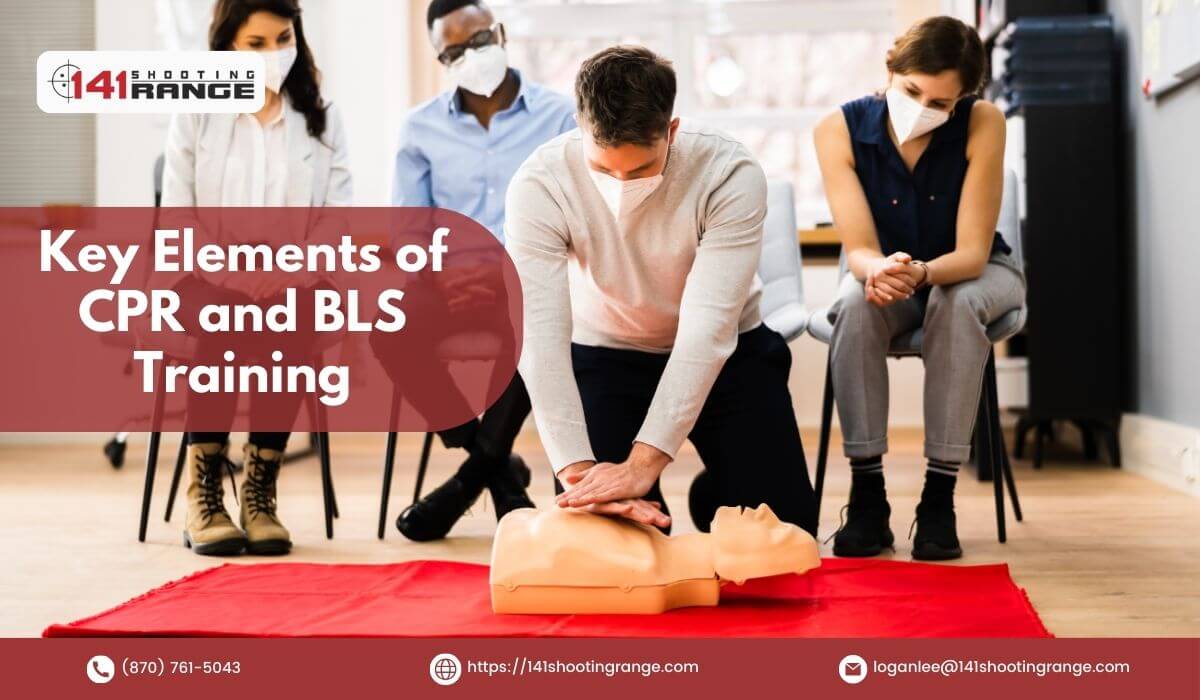The ability to save lives in critical situations makes CPR and BLS training significant. These life-saving techniques help people respond quickly to cardiac arrest, where seconds matter.
CPR training teaches chest compressions and rescue breaths to sustain blood circulation and oxygenation until assistance. Basic Life Support (BLS) training covers emergency treatment beyond CPR.
These trainings improve survival rates, reduce long-term impairments, and foster a preparation and well-being culture. CPR and BLS training also boosts responders’ confidence, enabling speedy and coordinated responses to life-threatening emergencies.
These abilities allow ordinary people to be quick responders and vital survival linkages, making them the foundation of public health.
Here are some core elements of CPR and BLS Training:
Key Elements of CPR and BLS Training:
Cardiopulmonary Resuscitation (CPR) Basics:
CPR aims to restore blood circulation and oxygenation by chest compressions and rescue breaths. It suggests using 100 to 120 compressions per minute and a compression depth of 2 inches. When administering compressions, it is a must to breathe in and out—understanding the essentials of CPR, including chest compressions, rescue breaths, and hand placement.
Defibrillator (AED) usage:
Defibrillators play a crucial role in restoring normal heart rhythms during cardiac arrests. If a person is unresponsive, not breathing, and does not have a pulse, an AED should be used. Follow the voice prompts on the AED and attach the pads to the chest quickly. If necessary, the AED will shock the person to restore a normal heartbeat.
Concept of the Chain of Survival:
Chain of Survival steps include recognition, prompt activation of emergency services, CPR, and advanced medical treatment. Four steps make up the Chain of Survival in CPR. Activating the emergency response system is the first step. Call for help as soon as you recognize the need for CPR. Keeping circulation and oxygenation is the second step of early CPR. The third step involves using an AED to restore normal heart rhythm. As a final step, medical professionals arrive to provide advanced life support.
Breathing techniques for rescue:
As well as chest compressions, rescue breaths are important. Tilt their head and lift their chin to ensure their airway is open. Create a seal by pinching their nose and covering their mouth. Watch the chest rise as you give two rescue breaths. Oxygen delivery and gas exchange are crucial to sustaining life during respiratory emergencies.
Quality chest compressions:
CPR requires quality chest compressions, and 100 to 120 compressions per minute are recommended. While performing the life-saving procedure, compressions should be at least two inches deep. Maintaining blood circulation and supporting vital organ function through consistent, deep, and properly timed chest compressions.
Safety and assessment of the scene:
Ensure both the rescuer’s and the victim’s safety before starting CPR. Ensure no fire, electrical wires, or unstable structures are on the scene. When the scene is safe, check the victim’s breathing and responsiveness—prioritizing scene safety and ensuring the responder and victim’s well-being during emergencies.

Algorithms and Decision-Making in BLS:
Providing effective CPR relies on BLS algorithms and decision-making. Based on the individual’s condition, these algorithms give step-by-step instructions for assessing the situation, taking appropriate actions, and making decisions. Healthcare professionals can increase patient outcome chances by following these algorithms and providing the best possible care. Becoming familiar with BLS algorithms will aid quick and effective decision-making for optimal patient care.
Team Dynamics and Communication:
Using two-way radios and mobile devices for real-time updates and coordination is an effective communication strategy for emergency responders. Furthermore, clear roles and responsibilities within the team and active listening can enhance communication and teamwork during emergencies. Enhancing emergency care efficiency and effectiveness through clear communication and collaboration.
Special Considerations for Different Age Groups:
Age-related considerations include adjusting chest compression depth and rate based on the victim’s size. Infants should be compressed with two fingers or the heel of one hand, while children and adults should be compressed with both heels. Adults should use more force when delivering rescue breaths than infants. Recognizing the differences in CPR and BLS approaches based on age and size for infants, children, and adults.
Ethical and legal considerations in CPR:
Legal implications can arise from administering CPR without training. Practicing CPR without a license or certification is known as practicing medicine without a license. During CPR, individuals can face legal responsibilities and lawsuits, especially if they sustain further injuries. To ensure compliance with legal and ethical considerations, it is essential to acquire the necessary training and certification. Providing CPR legally and ethically, including Good Samaritan laws, and acting responsibly during emergencies.
Practical Training at 141 Shooting Range:
141 Shooting Range is ideal for CPR and BLS instruction for various reasons. We provide life-saving emergency response training with a dedication to quality. 141 Shooting Range’s highly certified trainers provide current CPR and BLS knowledge and hands-on practice.
We introduce simulated circumstances to improve real-world abilities. Personalization guarantees that participants depart with certification and the confidence to act decisively in crucial situations. Whether you’re a beginner or a refresher, 141 Shooting Range promotes preparation and empowers people to respond to situations.
Frequently Asked Questions:
During BLS training, individuals learn essential life-saving skills, focusing on responding immediately to cardiac emergencies.
AEDs help restore a normal heart rhythm in cardiac emergencies, increasing survival chances.
The Chain of Survival outlines steps to maximize survival chances, including early recognition, activation of emergency services, and prompt CPR.
During an emergency, chest compressions keep blood flowing, essential for organ function.
Children, infants, and adults need several types of care, so BLS training is designed accordingly.
Team dynamics make emergency care more efficient by enhancing communication and coordination.
During CPR training, you’ll learn about legal and ethical issues, including Good Samaritan laws.
As an interim measure, post-resuscitation care provides ongoing support to those who have undergone resuscitation.








